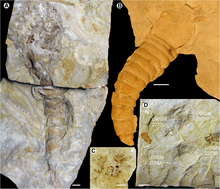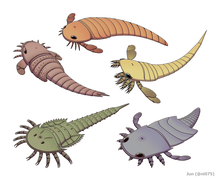| Chasmataspidida Temporal range: Possible Cambrian record[1]
| |
|---|---|

| |
| Fossils of Hoplitaspis hiawathai. | |

| |
| Reconstruction of Dvulikiaspis menneri (middle top), Octoberaspis ushakovi (top left), Hoplitaspis hiawathai (top right), Chasmataspis laurencii (bottom left) and Diploaspis casteri (bottom right). | |
| Scientific classification | |
| Domain: | Eukaryota |
| Kingdom: | Animalia |
| Phylum: | Arthropoda |
| Subphylum: | Chelicerata |
| Clade: | Dekatriata |
| Order: | †Chasmataspidida Caster & Brooks, 1956 |
| Clades | |
| |
| Synonyms | |
| |
Chasmataspidids, sometime referred to as chasmataspids,[1][2][3] are a group of extinct chelicerate arthropods that form the order Chasmataspidida. Chasmataspidids are probably related to horseshoe crabs (Xiphosura) and/or sea scorpions (Eurypterida),[4][1] with more recent studies suggest that they form a clade (Dekatriata) with Eurypterida and Arachnida.[5][6][7][8] Chasmataspidids are known sporadically in the fossil record through to the mid-Devonian,[9] with possible evidence suggesting that they were also present during the late Cambrian.[1] Chasmataspidids are most easily recognised by having an opisthosoma divided into a wide forepart (preabdomen) and a narrow hind part (postabdomen) each comprising 4 and 9 segments respectively.[1][10] There is some debate about whether they form a natural (i.e. monophyletic) group.[3][1][4]
- ^ a b c d e f Cite error: The named reference
Chasmataspis2004was invoked but never defined (see the help page). - ^ Cite error: The named reference
:0was invoked but never defined (see the help page). - ^ a b Cite error: The named reference
:1was invoked but never defined (see the help page). - ^ a b Garwood, Russell J.; Dunlop, Jason A. (2014). "Three-dimensional reconstruction and the phylogeny of extinct chelicerate orders". PeerJ. 2: e641. doi:10.7717/peerj.641. PMC 4232842. PMID 25405073.
- ^ Lamsdell, James C. (2013-01-01). "Revised systematics of Palaeozoic 'horseshoe crabs' and the myth of monophyletic Xiphosura". Zoological Journal of the Linnean Society. 167 (1): 1–27. doi:10.1111/j.1096-3642.2012.00874.x. ISSN 0024-4082.
- ^ Selden, Paul A.; Lamsdell, James C.; Qi, Liu (2015). "An unusual euchelicerate linking horseshoe crabs and eurypterids, from the Lower Devonian (Lochkovian) of Yunnan, China". Zoologica Scripta. 44 (6): 645–652. doi:10.1111/zsc.12124. ISSN 1463-6409. S2CID 55264483.
- ^ Lamsdell, James C.; Briggs, Derek E. G.; Liu, Huaibao P.; Witzke, Brian J.; McKay, Robert M. (2015). "A new Ordovician arthropod from the Winneshiek Lagerstätte of Iowa (USA) reveals the ground plan of eurypterids and chasmataspidids". The Science of Nature. 102 (9–10): 63. doi:10.1007/s00114-015-1312-5. ISSN 0028-1042. PMID 26391849. S2CID 8153035.
- ^ Lamsdell, James C. (2016). Zhang, Xi-Guang (ed.). "Horseshoe crab phylogeny and independent colonizations of fresh water: ecological invasion as a driver for morphological innovation". Palaeontology. 59 (2): 181–194. doi:10.1111/pala.12220. S2CID 85553811.
- ^ Cite error: The named reference
:3was invoked but never defined (see the help page). - ^ Dunlop, Jason A.; Lamsdell, James C. (2017). "Segmentation and tagmosis in Chelicerata". Arthropod Structure & Development. 46 (3): 395–418. doi:10.1016/j.asd.2016.05.002. ISSN 1467-8039. PMID 27240897.